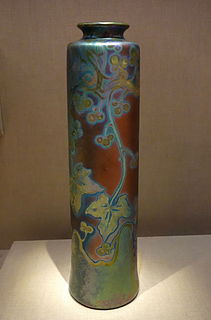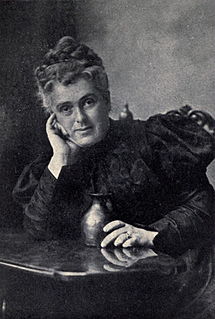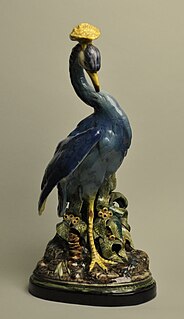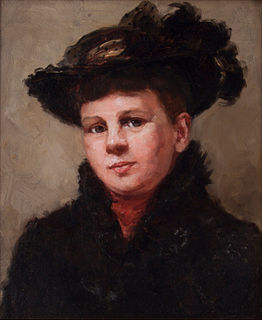Did Tj Wheatley Work for Cincinnati Art Pottery Co
Wheatley Pottery Visitor
Last updatedWheatley Pottery Company produced ornamental vases, lamps, and ceramic tile in Cincinnati, Ohio. Their autumn foliage tiles were used on the Franklin Building, along Printer'due south Row in Chicago. The MET has an earthenware umbrella stand up from the company in its collection. [1]
History
Thomas J. Wheatley worked in the Coultry pottery studio beginning in 1879 [two] with M. Louise McLaughlin of Rookwood Pottery. He started T.J. Wheatley & Co. in Cincinnati in 1880. One of the business firm'due south vases was exhibited every bit role of a Morse Museum testify. [3] He helped course the Cincinnati Fine art Pottery Visitor where he worked until 1882. Wheatley opened a studio in Cincinnati and a factory in Covington Kentucky almost the crossing to Cincinnati simply information technology closed later on flooding. [4] and Wheatley worked for Weller Pottery in Zanesville, Ohio from 1897 to 1900.
He founded Wheatley Pottery Company in 1903 in Cincinnati. The house suffered a burn in 1910. [5] It was purchased by the Cambridge Tile Manufacturing Company in 1927. The company is known for its use of relief in its decorative pottery and green, bluish, and yellow glazes. [6] Its vases haabe appeared on Antiques Roadshow . [7] [eight] Wheatley imitated the work of other artists including Limoges and Grueby Faience Visitor. [eight]
Wheatley patented a slip process adult by McLaughlin. [9] Information technology was disputed and he backed downwards from attempting to enforce information technology. [10]
Isaac Kahn was a partner in the business. [11] [12]
In 1921, the company moved from its institute at 4600 Eastern Avenue. [13] The firm besides had a showroom at 561 Reading Road. A fountain and some tilework was salvaged from it when it was demolished. [5]
1 of their catalogues featured a swastika tile design in the 1920s.
Related Research Manufactures

The four Martin Brothers were pottery manufacturers in London from 1873 to 1914. In their own solar day their Martinware was described as art pottery, and they were ane of the earliest potteries making this, but in modern terms they fit better into the studio pottery category, which was invented later.

Frederick Hurten Rhead (1880–1942) was a ceramicist and a major figure in the Arts and crafts movement. A native of England, worked equally a potter in the United states of america for near of his career. In add-on to teaching pottery techniques, Rhead was highly influential in both studio and commercial pottery. He worked for the Roseville Pottery, established his own Rhead Pottery (1913–1917), and in 1935 designed the highly successful Fiesta ware for Homer Laughlin China Company.

Mintons was a major company in Staffordshire pottery, "Europe'south leading ceramic manufactory during the Victorian era", an independent business from 1793 to 1968. Information technology was a leader in ceramic pattern, working in a number of unlike ceramic bodies, decorative techniques, and "a glorious pot-pourri of styles - Rococo shapes with Oriental motifs, Classical shapes with Medieval designs and Art Nouveau borders were among the many wonderful concoctions". Too every bit pottery vessels and sculptures, the firm was a leading manufacturer of tiles and other architectural ceramics, producing piece of work for both the Houses of Parliament and U.s. Capitol.

Van Briggle Art Pottery was at the time of its demise the oldest continuously operating art pottery in the United states, having been established in Colorado Springs, Colorado in 1901 by Artus and Anne Van Briggle. Artus had a significant impact on the Art Nouveau motion in the United states of america, and his pottery is foundational to American Art Pottery. The Art Nouveau mode favored past its founders continues to influence the pottery's designs.

In 1872, Samuel A. Weller founded Weller Pottery in Fultonham, Ohio, United States. Originally, his business consisted of a modest motel and one beehive kiln, and Weller produced flower pots, bowls, crocks, and vases. By 1905, Weller Pottery was the largest pottery in the country. It mass-produced art pottery until about 1920, and it produced commercial lines until the pottery airtight in 1948.
The Overbeck sisters were American women potters and artists of the Craft Movement who established Overbeck Pottery in their Cambridge City, Indiana, abode in 1911 with the goal of producing original, high-quality, hand-wrought ceramics every bit their primary source of income. The sisters are best known for their fanciful figurines, their skill in matte glazes, and their stylized designs of plants and animals in the Fine art Nouveau and Art Deco styles. The women owned and handled all aspects of their artistic enterprise until 1955, when the last of the sisters died and the pottery closed. Equally a result of their efforts, the Overbecks managed to become economically independent and earned a modest living from the sales of their art.

Maria Longworth Nichols Storer was the founder of Rookwood Pottery of Cincinnati, Ohio, United States, a patron of fine art and the granddaughter of the wealthy Cincinnati businessman Nicholas Longworth.

Mary Louise McLaughlin was an American ceramic painter and studio potter from Cincinnati, Ohio, and the main local competitor of Maria Longworth Nichols Storer, who founded Rookwood Pottery. Like Storer, McLaughlin was one of the originators of the art pottery movement that swept the United States.

Kataro Shirayamadani, besides known as Kitaro Shirayamadani was a Japanese ceramics painter who worked for Rookwood Pottery in Cincinnati, Ohio from 1887 until 1948.

Adelaide Alsop Robineau (1865–1929) was an American china painter and potter, and is considered one of the top ceramists of American art pottery in her era.

Fine art pottery is a term for pottery with artistic aspirations, fabricated in relatively pocket-size quantities, more often than not between about 1870 and 1930. Typically, sets of the usual tableware items are excluded from the term; instead the objects produced are more often than not decorative vessels such as vases, jugs, bowls and the like which are sold singly. The term originated in the subsequently 19th century, and is usually used merely for pottery produced from that menstruation onwards. It tends to exist used for ceramics produced in factory weather condition, but in relatively small quantities, using skilled workers, with at the least close supervision by a designer or some sort of artistic director. Studio pottery is a step up, supposed to be produced in even smaller quantities, with the hands-on participation of an creative person-potter, who often performs all or near of the production stages. But the use of both terms can exist elastic. Ceramic art is oftentimes a much wider term, covering all pottery that comes inside the scope of art history, but "ceramic artist" is often used for hands-on artist potters in studio pottery.

Heath Ceramics is an American company that designs, manufactures, and retails goods for tabletop and dwelling house, and is best known for handcrafted ceramic tableware and architectural tile in distinctive glazes.

Hugh C. Robertson, (1845–1908), was the first American studio potter who experimented with new ceramic glazes. Built-in in England, Robertson apprenticed at the Jersey City Potter in 1860. In 1868, he started piece of work in his father's shop that had opened in 1866 in Chelsea, Massachusetts. In 1872 the factory was incorporated into the Chelsea Keramic Art Works (CKAW). The company became known for their antique Grecian terracotta and Pompeian bronzes. In 1877, Robertson developed the Chelsea faience, underglazed opaque earthenware, which led the evolution of other American faience. In that location in 1884, Robertson worked on discovering the famous Chinese sang de boeuf glaze. In 1888, he finally discovered the recipe for the glaze and produced three hundred pieces of what he dubbed, Sang de Chelsea.

Rookwood Pottery is an American ceramics visitor that was founded in 1880 and closed in 1967, earlier being revived in 2004. It was initially located in the Over-the-Rhine neighborhood in Cincinnati, Ohio, and has now returned there. In its heyday from about 1890 to the 1929 Crash. it was an of import manufacturer, by and large of decorative American art pottery made in several fashionable styles and types of pieces.

California pottery includes industrial, commercial, and decorative pottery produced in the Northern California and Southern California regions of the U.Southward. state of California. Production includes brick, sewer piping, architectural terra cotta, tile, garden ware, tableware, kitchenware, art ware, figurines, giftware, and ceramics for industrial use. Ceramics include terra cotta, earthenware, porcelain, and stoneware products.

The Shawnee Pottery Company was a manufacturing company best known for producing Corn King pottery and the Pennsylvania Dutch lines of pottery. Both of these lines are considered to exist highly collectible.

Clara Chipman Newton was an American artist all-time known as a painter of porcelain and prc.

Albert Robert Valentien (1862–1925) was an American painter, botanical artist, and ceramic artist. He is best known for his work as the main ceramics decorator at Rookwood Pottery, and for his watercolor paintings of botanical subjects. In 1908, he accustomed a commission from philanthropist Ellen Browning Scripps to illustrate the botanical multifariousness of California. Over the next ten years, he produced approximately 1200 watercolor "plant portraits" of native California wildflowers, grasses, ferns, and copse.

American art pottery refers to aesthetically distinctive hand-made ceramics in earthenware and stoneware from the catamenia 1870-1950s. Ranging from tall vases to tiles, the work features original designs, simplified shapes, and experimental glazes and painting techniques. Stylistically, most of this piece of work is affiliated with the modernizing Craft (1880-1910), Art Nouveau (1890–1910), or Art Deco (1920s) movements, and also European fine art pottery.

The J. B. Owens Pottery Visitor, informally known every bit Owens Pottery, was an American art pottery and tile visitor that flourished for a few years effectually the turn of the 20th century.
References
- ↑ "Info". world wide web.metmuseum.org . Retrieved 2019-06-08 .
- ↑ "Glass & Pottery World". Trade Magazine Association. viii June 2019 – via Google Books.
- ↑ "American Art Pottery at the Morse Museum, Winter Park, Florida". www.morsemuseum.org.
- ↑ Frelinghuysen, Alice Cooney; Eidelberg, Martin; Spinozzi, Adrienne (September 25, 2018). American Art Pottery: The Robert A. Ellison Jr. Collection. Metropolitan Museum of Fine art. ISBN 9781588395962 – via Google Books.
- 1 2 "OH__Cincinnati--Wheatley Tile Company Showroom - Historic U.S. Tile Installations, O-W". sites.google.com.
- ↑ "History of Wheatley Pottery - Simply Art Pottery". www.justartpottery.com.
- ↑ "Antiques Roadshow | PBS". Antiques Roadshow | PBS.
- 1 2 Posted ten.05.2015, Dylan Hayley Leavitt. "Antiques Roadshow | PBS". Antiques Roadshow | PBS.
- ↑ Ellis, Anita J.; McLaughlin, Mary Louise (March 8, 2003). The Ceramic Career of Thousand. Louise McLaughlin. Ohio Academy Press. ISBN 9780821415047 – via Google Books.
- ↑ Zipf, Catherine W. (eight June 2019). Professional person Pursuits: Women and the American Arts and Crafts Movement. Univ. of Tennessee Press. ISBN 9781572336018 – via Google Books.
- ↑ "Williams' Cincinnati Business Directory". Williams Directory Company. March eight, 1909 – via Google Books.
- ↑ Evans, Paul (March 8, 1987). Art Pottery of the United states: An Encyclopedia of Producers and Their Marks, Together with a Directory of Studio Potters Working in the U.s. Through 1960. Feingold & Lewis Publishing Corporation. ISBN 9780961957704 – via Google Books.
- ↑ "Brick and Clay Record". Kenfield-Leach. March 8, 1921 – via Google Books.
This page is based on this Wikipedia article
Text is bachelor under the CC BY-SA iv.0 license; additional terms may employ.
Images, videos and sound are available nether their respective licenses.
Source: https://wikimili.com/en/Wheatley_Pottery_Company
0 Response to "Did Tj Wheatley Work for Cincinnati Art Pottery Co"
Post a Comment